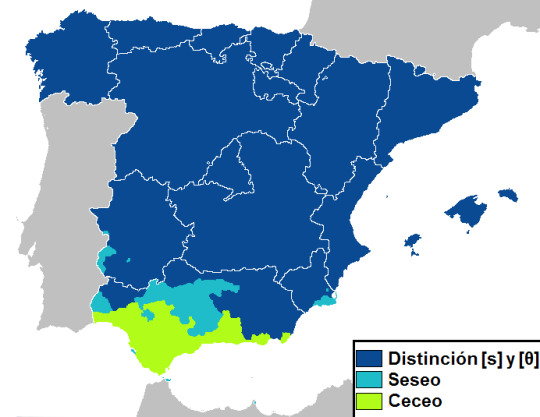#european spanish
Explore tagged Tumblr posts
Text
"So Spain doesn't have a lisp?" Distinción 101
So in my last post I mentioned if you're not a native Spanish speaker and/or you don't know how the TH/S sounds work you should refrain from incorporating that into your work (and especially describing Spain's speech pattern as someone with a lisp) as those of us who know will notice. However someone has asked me to explain how diferenciación/distinción works which is what I'll do in this post.

As you may have noticed, or seen in very inaccurate memes, in Spain we pronounce some words with a TH sound. But, is that considered a lisp? Well, no, since a lisp is a speech impediment. That'd be as nonsensical as saying that English speakers have a lisp because they call this (1000) number thousand, or they call the thing that shakes in the sky thunder, or that Greeks have a lisp because they have a bunch of words like thalasso.
What we have is distinción or diferenciación which is a phonemic distinction made between the sounds represented by the letters "s" and "z" (or soft "c" before "e" and "i").
How do you know how to pronounce each sound?
Za, ze, ce, zi, ci, zo, zu = TH
Sa, se, si, so, su = S
(so, no, we don't pronounce sí like "thí", or España like "Ethpaña" as some may have you believe)
This is actually very useful when writing because we know exactly whether we should write a word with a Z or an S depending on how it sounds. Spanish speakers of other dialects may get confused when they learn how to write as children, as they have to memorise if words are written with Z or S. We don't need to do that.
It's also useful when telling apart two words that sound very similar. For example:
"Casa" ("house") is pronounced caSa.
"Caza" ("hunt") is pronounced with caTHa.
Does everyone in Spain speak with distinción / diferenciación?
No! As you can see in the map below, even though most people do the distinción, some people in Spain speak with seseo and some others speak with ceceo.

Seseo consists in pronouncing everything with a S sound. This is the characteristic found in all of the dialects in Latin America, as well as in some parts of the south of Spain and the Canary Islands (not pictured in the map, smh). So for example, they'd pronounce "zapato" ("shoe") as sapato.
Ceceo is the opposite of seseo, so, pronouncing everything with a TH sound. This is also found in the south of Spain. People who do ceceo would typically pronounce a word like "sandía" ("watermelon") as thandía.
So, is ceceo a lisp? Still, no. Most people who speak with ceceo are able to switch to distinción, even if it doesn't come natural to them, so it can't be a speech impediment. In fact, a lot of them are more or less forced to, especially if they move out of the southern regions, as people who speak with ceceo are stereotypically regarded as dumb and unprofessional and are usually the target of classist jokes.
European Spanish (especially the southern/Andalusian dialect) is so diverse when it comes to phonetics and vocabulary, that even within the same city or town you'll find people who pronounce things differently. Which means, not every inhabitant of the part of the map colored as "ceceo" is going to speak with ceceo.
For example, this is the data of three cities in the south, when studying if people do ceceo, seseo or distinción:

I personally spoke with ceceo as a child, as I learned how to talk in a town where people do that, but I was corrected out of it because of concerns regarding the stereotype I just told you. It slips from time to time but I mostly speak with diferenciación now.
Now that I've explained all of this, you probably already know how we'd pronounce the word "distinción", right? It's diStinTHión.
So which accent would Hetalia's Spain have?
Unlike characters like Romano, we don't know which part of the country Spain would be from, so we cannot know which specific dialect he speaks. In the official Spanish dub he does speak with distinción but that's because dubs are usually done in Madrid's accent (which is considered to be the "neutral" one).
If you want to go the safe route, I'd say distinción is the way, since it can be found even in cities where ceceo or seseo predominate. Unless he was from the Canary Island: there's no way he'd speak with other than seseo then.
If you're doing fan work it's very unlikely that you have to use any of these phonetics anyways, since most content is done in English. The point of my explanation is mostly to let you know that:
no, Spaniards don't have a lisp.
there's no such thing as just one "Spanish from Spain" dialect.
mocking people who do the TH sound is actually classist and very uncool.
That's all for today! If you have any questions please let me know :)
#2 educational posts in a row damn i feel like a teacher#hws#hws spain#aph#aph spain#hetalia#antonio fernandez carriedo#spanish#european spanish#spanish from spain#ceceo#seseo
17 notes
·
View notes
Text
My accent in Spanish is thick af, though in the strangest way possible, because I'm a Portuguese speaker who was taught Spanish by European Spanish speakers but watched Latin American media and lived in Cuba.
Like, will my accent be Latin American, European, or Portuguese for my next word?
Who knows! I sure don't!
All I know is that native Hispanics will find it hilarious.
#latin american spanish#european spanish#spanish#brazilian portuguese#portuguese#the real life of me#spanish langblr#spanish language#langblr
48 notes
·
View notes
Text
Watching a lot of Spanish shows makes me realize that a lot of white people are more Spanish than they think 🤔
#Spanish#european spanish#sometimes i'm watching a show and I'm like why this dude look like someone I went to college with?#it's kind of funny
1 note
·
View note
Text
WHAT ARE YOU DOING HERE? (european spanish dub)
4 notes
·
View notes
Text

disclaimer yo no hice el meme namás lo saqué del feisbu
#(i know guyana and haití have english and french respectively as their most talked languages but the percentage that knows spanish#is way more real than the europeans)
11K notes
·
View notes
Text

Rafael Romero Barros (Spanish, 1832-1895) Still life with oranges, 1863
#Rafael Romero Barros#spanish art#spanish#hispanic#latin#still life#bodegon#1800s#art#fine art#european art#classical art#europe#european#oil painting#fine arts#western civilization#europa#mediterranean#southern europe#traditional art#painting#oranges#orange#harvest#spring
13K notes
·
View notes
Text

Wool & lana
The word lana (wool) in languages such as Spanish is etymologically related to English wool. For words to be related, they don't have to look like each other. Instead, you have to be able to trace them back to the same ancestor through regular sound changes - and that's what linguists managed to do with wool and lana. The infographic shows the Germanic and Romance family trees of these words.
#historical linguistics#linguistics#language#etymology#english#latin#french#dutch#german#spanish#proto-indo-european#proto-italic#proto-germanic#gothic#norwegian#swedish#old norse#danish#icelandic#catalan#portuguese#italian#romanian#low saxon#frisian#lingblr
686 notes
·
View notes
Text

The Mancorbo Canal in the Picos de Europa by Carlos de Haes
#carlos de haes#art#picos de europa#mountains#mountain#landscape#spain#europe#european#nature#spanish#picturesque#cattle#cows#animals
979 notes
·
View notes
Text


Chocolate Basque Cheesecake
#chocolate#basque#cheesecake#cream cheese#food#dessert#baking#recipe#european#spanish#dark chocolate#gluten free#flourless#jajabakes
841 notes
·
View notes
Text

"Women could be found working on construction sites, if only occasionally, including in specialized roles such as carpenters and masons. The research is found in the article, “Appropriate to Her Sex?” Women’s Participation on the Construction Site in Medieval and Early Modern Europe,” by Shelley E. Roff.
She surveyed a wide variety of records from throughout Western Europe, including tax records, inventories of wages paid on construction sites, and municipal accounts, and discovered numerous instances of women working alongside men on construction sites as far back at the 13th century. Most of these women were employed as day laborers, carrying out tasks such as moving water and building supplies around the sites, digging ditches and serving as assistants to bricklayers and stonemasons. For example, in the Spanish city of Seville during the 14th century, women were hired to dig trenches for the foundation of a new city wall, while at the nearby city of Toledo, one or two women were hired each day for the construction of the city’s cathedral, where they gathered lime and worked on the roof. Meanwhile in the French city of Toulouse, almost half the laborers working on the Perigord college site were women. Ross also finds several examples from England and Germany.
Roff notes that previous historians have seen many examples of women working on construction sites in their research, but they had believed that these were just abnormal exceptions caused by economic crises, or because the male population had been killed off through war or disease. But her new study suggests that women construction workers were more than just odd occurences. She explains that “the expansion of urban centers starting in the thirteenth century set off a trend of increasing female employment for day laborers and in the crafts, which only began to contract on occasion for women working in the crafts in the sixteenth century with ensuing economic crises.”
She also notes that in almost all accounts surveyed, the women were paid at a lower rate than the men, which would make the “a cost-effective solution” for site supervisors looking for ways to reduce expenses. The women who took these jobs would have come from society’s poor – those women who could not maintain their households and families just from their husbands’ (if they had one) income.
Roff also finds records showing women taking part in specialized building trades. In London in 1383, Katherine Lightfoot is recorded as the supplier of 2,000 painted tiles for bath in the King’s palace. Meanwhile, tax records from Paris during the years 1296 and 1313 reveal the existence of two female masons, a tiler and a plasterer. These women were not poorer individuals, rather they were the wives of male craftsman, and in some cases their widows. The 15th-century French writer Christine de Pizan noted in her book The Treasury of the City of Ladies that craftswomen, “should learn all the shop details so that she can properly supervise the workers when her husband is away or not paying attention.”
Women workers could be found on the medieval construction site, Medievalists.net
#history#women in history#women's history#working women#historyedit#middle ages#medieval women#medieval history#european history#french history#spanish history#historical#historyblr
796 notes
·
View notes
Text




A fantastically chiseled and gilt Rapier,
OaL: 45.5 in/115.6 cm
Blade Length: 39.5 in/100.3 cm
Width: 6.5 in/16.5 cm
Depth: 3.4 in/8.6 cm
Weight: 2.1 lbs/935.5 g
Spain, ca. 1590, housed at the Metropolitan Museum of Art.
634 notes
·
View notes
Text

The Guaxa, also called the Guajona, has often been seen wandering the forests of northern Spain, where she has made her home. She appears mostly human but can be distinguished by her bird feet and single long tooth with which she punctures the veins of her victims so as to feast on their blood.
#ink art#manga art#traditional art#fantasy art#mythology and folklore#cantabrian myth#spanish folklore#folk horror#european myth#vampire
340 notes
·
View notes
Text

Portrait of Dora Gedon as a Flamenco Dancer
By Corneille Max
#art#painting#fine art#classical art#german art#german artist#german painter#oil painting#portrait#female portrait#spanish culture#spain#culture#european art#flamenco#european culture#southern europe
335 notes
·
View notes
Text

She's a little confused, but she, uh... she's, she's a little confused.
#psychrodraws#pokemon scarlet and violet#pokemon sv#pokemon#arven#arven pokemon#nemona#nemona pokemon#penny#penny pokemon#transgender#genderfluid#spanish#lgbtqia#european
205 notes
·
View notes
Text








franco colapinto + what gets lost in translation
R.F Kuang, Babel, Or the Necessity of Violence / Miguel de Cervantes, Don Quijote de la Mancha / R.F Kuang, Babel, Or the Necessity of Violence / John Ciardi, Translator's Note in Dante's Inferno
i've seen in the past days multiple interviews by franco in spanish that have been translated to english. there isn't a single way to translate, nor there is there a way to convey everything that is being said when translating. as someone that translates from english to spanish and viceversa frequently, a language does not stand on it's own. it has a culture, a context, mannerisms that don't really exists in the language it's being translated to, and all a translator can do is try and convey everything the best they can just using words.
franco is, after all, argentinian, and has spanish as first language. he prefers to talk in spanish over english, and with the rise of translations due to the amount of interviews he does in spanish, i've seen a lot of either mistranslations or translations that don't fully convey the context or the nuances of what is being said, and act like franco textually said that.
that's why i urge non-spanish speaking people to not take every translation as it is. dig a bit deeper before misinterpreting translations of what he said. language isn't just a mash of words that can be translated one-to-one and still keep the same meaning.
with that said, i want to dedicate this web weaving to @divorcedpierresteban, the ennabler of me making this.
#franco colapinto#f1#formula 1#web weaving#quotes#azda.weaves#this is a veryyy self indulgent web weaving bc yeah <3#kinda tired of seeing ppl drag him multiple times based on translations that are either plain bad or just don't have the context#argentinian and latam culture in general is different to european#and franco is very proud of being argentinian which is great to see#there's subtext there's context there's so much than just the words#ALSOO he's so much funnier in spanish ngl
221 notes
·
View notes
Text

Juan de la Abadía el Viejo (The Elder) (Spanish, c.1470-1498) Saint Michael the Archangel, c.1486 Museo Lázaro Galdiano, Madrid
#Gothic#Spanish Flemish#Flemish#juan de la abadia the older#art#fine art#european art#classical art#europe#european#fine arts#oil painting#europa#mediterranean#juan de la abadia el viejo#spanish art#spanish#spain#1400s#saint michael#archangel#angel#devil#saint michael the archangel defeated the devil
2K notes
·
View notes